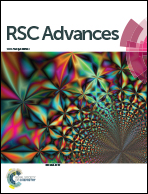Study on the photophysical and electrochemical property and molecular simulation of broadly absorbing and emitting perylene diimide derivatives with large D–π–A structure†
Abstract
To obtain broadly absorbing perylene derivatives with the synchronous impact of the intrinsic π–π* transition of a large conjugated system and intramolecular charge transfer (ICT), we report here the facile synthesis and physical characterization of new N,N′-(di-n-octyl)-3,4,9,10-perylenetetracarboxylic acid diimides (PDI) bearing benzyl-substituted quinoline-4(1H)-ylidene-methyl units as effective donors on the 1,7-positions (C1) and 1-position (C2). Compared to unsubstituted PDI, C1 and C2 both show a pronounced bathochromic shift to the near-infrared region, a high molar extinction coefficient, concentration-dependent π–π-stacking-induced fluorescence and a low LUMO energy level. The investigation of spectroscopic properties and molecular simulation reveal an effective ICT character in compounds C1 and C2. All the properties and analysis indicate that the derivatives are efficient at solar harvesting and are potential candidate materials for use in photovoltaic devices and photocatalysts.


 Please wait while we load your content...
Please wait while we load your content...